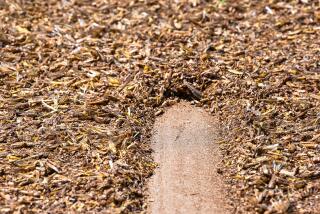Artichokes : That’s the ‘Chokes, Folks
Artichoke farming is not for everyone. Because the plants stay in the ground for years, change comes very slowly--especially compared to crops such as lettuce, where a combination of good field, good farmer and good luck can sometimes bring in four harvests in a year.
If lettuce farmers are the Las Vegas gamblers of the vegetable world, always rolling the dice to make a fortune on the next great market, artichoke farmers are more likely to put their money into something safe and conservative--like maybe a mattress.
“Lettuce, you get two or three crops per year and if you hit a market at a decent price you can pay for the whole year,” says Al Pieri, son of Castroville artichoke pioneer Dan Pieri. “With artichokes, you’ll never make a big killing like with some crops, but you’ll never take a great loss like with some crops.”
Not that growing artichokes is trouble-free. Far from it. The crisis of the moment in the Salinas Valley (for the last 20 years or so, in fact) is water use. Heavy pumping of wells for irrigation water has depleted the aquifer around Castroville to the point that seawater is showing up in what were freshwater wells. To take care of that, the Monterey County Water Resources Agency is building a $70-million water reclamation plant and pipeline that will allow irrigation with reclaimed sewage water. Growers are also in the process of switching to more efficient drip irrigation.
In rainy years like this one, there are other water problems. The artichoke bud is prone to various kinds of spoilage brought about by excess moisture. Because spoiled artichokes never make it to market, this year’s crop is apt to be smaller than usual because of that.
Other problems are even more difficult. Having 6,000 acres of one kind of plant in the ground in one place for more than 60 years is kind of like putting up a big neon sign inviting every pest in the area to come and dine. Between artichoke plume moths and voles, artichoke farmers have plenty to keep them busy. In bad years, moths alone have accounted for 70% drops in artichoke production. Even when they are controlled by spraying, damage can amount to 50%.
*
That’s where artichoke breeder Dr. Neil De Voss comes in. His main project is developing artichokes that can be grown from seed. That is neither as insignificant nor as simple as it seems. In the first place, growing artichokes from seed would allow farmers to rotate crops, cleaning out fields from harvest to harvest and making it harder for pests to concentrate on particular areas.
It would also allow farmers to set their harvest schedules better. As it is, there usually is a scarcity of artichokes for 10 months of the year, followed by a tremendous glut in March and April, when all of a sudden every plant gets its chill requirements at the same time and decides to go into production.
That the project can last this long and still not be completed tells you something about the genetic craziness of artichokes. They rarely breed true. Even plants grown from root division can change, and it’s not uncommon for one stalk of a plant to produce artichokes that look different from the rest of the plant.
What happens to an ordinary artichoke is this: After a certain amount of chilly weather, the plant decides summer must be just around the corner and sends up flower stalks. Then the plant tries to go to seed.
Not so fast, bud. It takes a certain amount of heat to do this, and if it’s a Castroville artichoke you’re dealing with, the plant is going to wait . . . and wait . . . and wait. Though the artichoke will flower if ignored long enough, it will rarely produce seed.
“If I had to produce seed around here, I’d never get anything done,” De Voss says. “What we’re doing is growing the artichoke in an environment in which we are knocking the hell out of its natural cycle.”
But seeds aren’t everything. In the Mediterranean, where seeds appear more readily, artichoke buds must be picked within a matter of days before they flower. In Castroville, harvest can wait more than a week. Another advantage of the fog is that--while it keeps things downright chilly during the day--it also holds in the heat at night. Artichokes are cold-sensitive, but it’s very rare for a serious freeze to hit the Castroville area.







